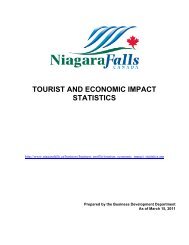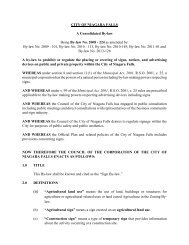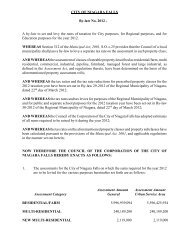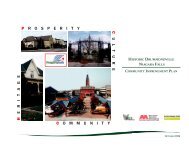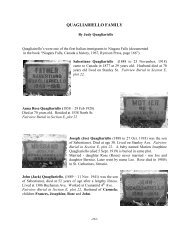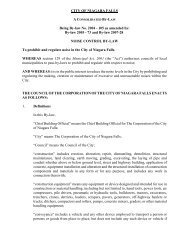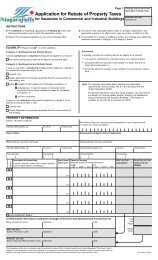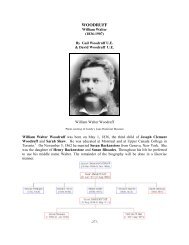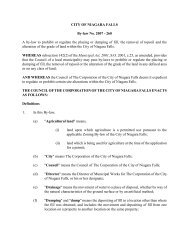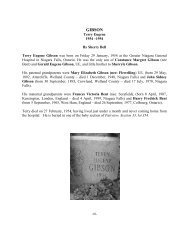DSA Report 6121 Lundy's Lane - Niagara Falls, Ontario, Canada
DSA Report 6121 Lundy's Lane - Niagara Falls, Ontario, Canada
DSA Report 6121 Lundy's Lane - Niagara Falls, Ontario, Canada
You also want an ePaper? Increase the reach of your titles
YUMPU automatically turns print PDFs into web optimized ePapers that Google loves.
Designated Substances and Select Hazardous Materials Assessment <strong>6121</strong> Lundy’s <strong>Lane</strong>, <strong>Niagara</strong> <strong>Falls</strong>, <strong>Ontario</strong><br />
Scope of Work<br />
To produce the information required to meet Section 30 of the Occupational Health and Safety Act, OESN developed<br />
and implemented the following scope of work for the property located at <strong>6121</strong> Lundy’s <strong>Lane</strong>, <strong>Niagara</strong> <strong>Falls</strong>, <strong>Ontario</strong>:<br />
1. Identify and locate materials suspected of containing designated substances or other potentially hazardous<br />
substances throughout the interior and exterior of the building<br />
2. Collect bulk samples of materials suspected to contain designated substances and submit for analysis<br />
3. Document items suspected of containing designated substances and hazardous materials<br />
4. Document the bulk sampling and inspection methodology, assessment findings, and results of analytical<br />
work<br />
Bulk Sampling and Analysis Methodology<br />
General building assessment techniques and principles were applied for materials suspected of containing<br />
designated substances and select hazardous materials. All accessible materials suspected of containing designated<br />
substances were sampled and analyzed for the purpose of a Designated Substances and Select Hazardous<br />
Materials Assessment.<br />
The determination of materials to be sampled was based on the experience and knowledge of an OESN<br />
representative regarding the historical use of designated substances and hazardous materials in building materials.<br />
Trisha McPherson of OESN carried out the visual inspection and material bulk sampling at <strong>6121</strong> Lundy’s <strong>Lane</strong>,<br />
<strong>Niagara</strong> <strong>Falls</strong>, <strong>Ontario</strong>.<br />
Bulk Collection Methodology for Asbestos Samples<br />
Asbestos bulk sampling was performed using the method stated in Section 3 of O. Reg. 278/05 as amended.<br />
Sampling strategy for bulk sampling of asbestos included for the development of a homogeneous materials sampling<br />
coding system. Homogeneous is defined as materials similar in composition, colour and texture.<br />
The sampling plan for asbestos has the following coding system:<br />
HF–01<br />
HF – Homogeneous Floor Material (W - Wall, C - Ceiling, T - Thermal, M - Manufacturing)<br />
01 – The first homogeneous floor material sampled<br />
Analysis Methodology for Asbestos Samples<br />
All bulk samples collected during the assessment were sent to CEI Labs for analysis. CEI Labs is accredited by the<br />
National Voluntary Laboratory Accreditation Program (NVLAP). Samples were analyzed using Polarized Light<br />
Microscopy (PLM). Sample preparation and analytical procedures are done in compliance with the procedures<br />
described in U.S. EPA Method 600/R93/116 Method for the Determination of Asbestos in Bulk Building Materials<br />
dated June 1993. Other procedures also utilized to supplement this method are described in Environmental<br />
Laboratory Accreditation Program 198.1. (ELAP 198.1).<br />
Bulk Collection Methodology for Lead, Mercury and Arsenic Samples<br />
Sampling strategy for bulk sampling of lead, mercury and arsenic included for the development of a homogeneous<br />
sampling coding system.<br />
2




